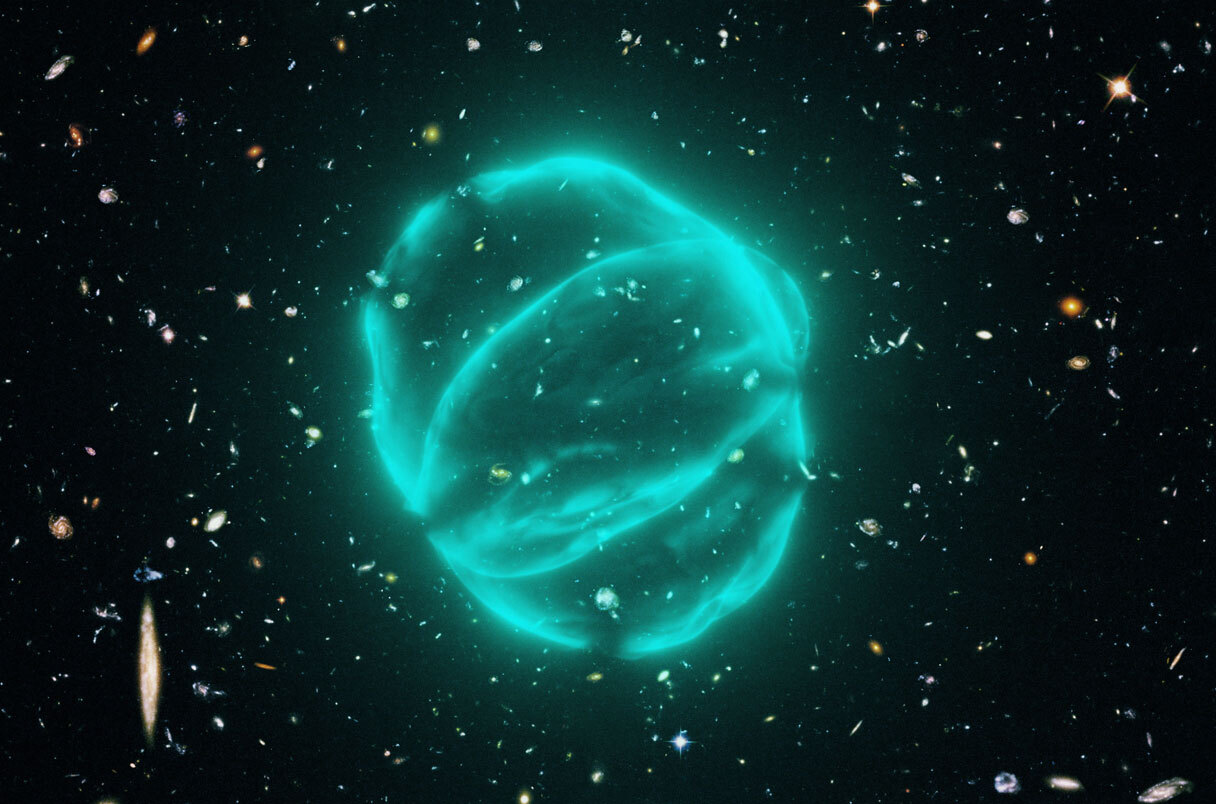10.01.2024
Eerie rings bigger than galaxies may result from ancient bursts of star formation

An artist’s impression of an odd radio circle. The mysterious rings could be the result of gas blasted out of a central galaxy after a burst of star formation.CSIRO
Since 2019, astronomers have puzzled over odd radio circles (ORCs), curious rings that pop up in sky surveys at radio wavelengths. At least one of the rings was likely caused by a burst of stars that formed in a distant galaxy and then exploded, blasting gas out into surrounding space, a team of astronomers told the American Astronomical Society meeting in New Orleans today. When that gas hit slower moving gas around the galaxy, it created a shock wave that generated an eerie ORC more than 10 times as wide as the Milky Way.
“It’s a very exciting finding and their scenario, at first glance, looks plausible,” says astronomer Sumit Sarbadhicary of Ohio State University. Amitesh Omar of the Aryabhatta Research Institute of Observational Sciences agrees: “I think this is an important paper towards demystifying the nature of ORCs around galaxies.”
The Australian Square Kilometre Array Pathfinder (ASKAP), a collection of 36 radio dishes each 12 meters across, spotted the first ORCs in 2019. Less than a dozen ORCs have been found to date, and they haven’t given much away. Some astronomers thought they might be caused by debris expanding outward from a supernova explosion in or near our own galaxy. But in a paper published in October 2023, Sarbadhicary and his colleagues compared six ORCs with models of supernovae remnants and concluded only one could plausibly fit that mold.
Most astronomers believe ORCS are large, distant objects—and many seem to enclose a galaxy at their center. Many galaxies contain central supermassive black holes, which can consume surrounding matter and fire out jets of material in opposite directions. These can appear in radio waves as two giant lobes when they hit gas surrounding the galaxy. Galaxies can also fling out debris when their central black hole consumes a whole star—a “tidal disruption event”—or when galaxies merge and two black holes coalesce. But astronomers have struggled to support those explanations because the radio emission from ORCs is featureless and they don’t appear to emit light at other wavelengths.
A clue to a different explanation emerged after Alison Coil of the University of California, San Diego, and her colleagues booked time on one of the Keck telescopes in Hawaii to observe at optical wavelengths an ORC known as ORC4. They discovered fluorescent light from oxygen atoms, known as OII, that typically occurs when ultraviolet light from bright young stars ionizes oxygen in surrounding gas clouds. When the ions regain their electrons, they fluoresce. As a result, astronomers use OII to measure how much star formation is happening in a galaxy.
But the OII signal from ORC4 covered almost the whole galaxy and was 10 times as bright as normal, Coil says. “There was an insane amount of OII, way more than there is normally.” The gas also showed a much wider range of velocities than expected, suggesting it was churning vigorously. “What could this possibly mean?” Coil recalls thinking.
Using a computer model of the system, described in a paper published today in Nature, she and her colleagues believe they have an answer. The scenario that best fits the data is that 1 billion years earlier, the galaxy at ORC4’s center underwent a brief but intense period of star formation. Such “starbursts” tend to produce big stars that burn brightly and quickly run out of fuel, so after a few million years the stars explode as supernovae. This fusillade of explosions in quick succession produces a powerful galactic wind blowing gas out of the galaxy.
When that wind hits the thin gas outside the galaxy, it creates a shock wave. What the radio arrays are seeing in the case of ORC4 is that shock wave after it has grown to enormous size and slowed down, 1 billion years later. Inside the shock wave, fast moving electrons spiral around magnetic field lines and generate radiation known as synchrotron light. In the aging shock wave of ORC4, those gyrations are leisurely, and produce the radio waves seen in ORC4.
The model also predicted that in such a short, sharp starburst, the tail end of the galactic wind can stall and start to fall back toward the galaxy. It then produces a second shock wave as it barrels into the galaxy again, which could ionize more oxygen atoms and explain the unusual production of OII light. Although the extent of the OII emission is one-tenth that of the radio circle, “a connection between the two will almost certainly exist,” Omar says.
The model doesn’t reveal what caused the burst of star formation in the first place. But Coil’s hunch is that it was sparked by a merger of similar-size galaxies. Such mergers compress gas clouds and set star formation alight. The team hopes to firm up its model by looking at ORC4 in more detail with Keck, and by studying several others with Europe’s Very Large Telescope in Chile.
Confirmation would do more than just solve the ORC mystery. It would also give astronomers new insights into starbursts and their effects. The galactic winds they produce are difficult to detect once they’ve emerged from the galaxy. ORCs, on the other hand, are “a relic of a past outflow grown to enormous size,” Coil says, allowing astronomers to “trace gas far outside the galaxy.” Sarbadhicary agrees and says learning to use ORCs to track past gas outflows would be “very important for the field.”
Quelle: Science AAAS

